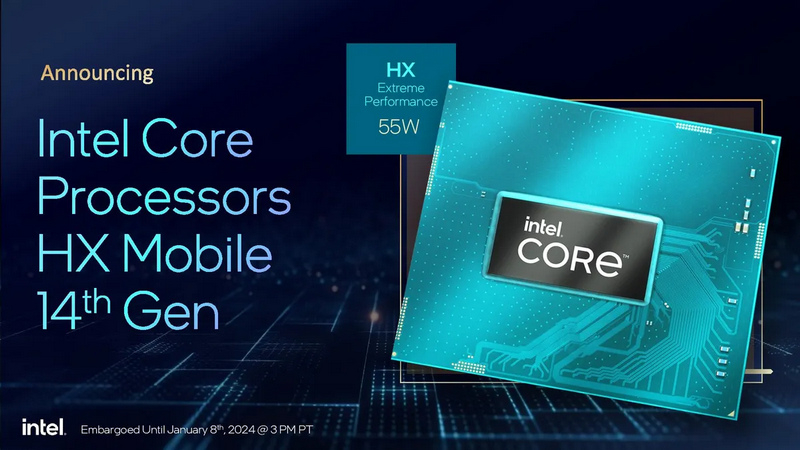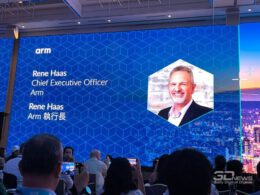At CES 2024, Intel launched its 14th-generation Core HX processors, designed for gaming and professional laptops, reputed as its most powerful mobile processors to date. The new chips belong to the Raptor Lake Refresh family, manufactured by Intel 7, and offer up to 24 cores.
Similar to the previous generation’s Raptor Lake chips, the new Raptor Lake Refresh continues utilizing the hybrid architecture encompassing performance-oriented P-cores Raptor Cove and energy-efficient E-cores Gracemont. Intel has increased the number of E-cores and L3 cache in core i7 chips while keeping the core total in Core i9 and Core i5 models unchanged. Intel has revealed five HX-series processors in total.
Intel’s brand-new Core i9-14900HX now heads its list of most powerful mobile processors. This 24-core, 32-thread processor is capable of accelerating up to 5.8GHz. The new model has clock frequencies of both its P-core and E-core increased by 400 MHz and 200 MHz, respectively, compared to the older Core i9-13900HX. The Core i9-14900HX also outperforms the previous champion, Core i9-13980HX, by 200 MHz.
The Core i7-14700HX has seen some significant upgrades compared to its predecessor:
it sports four more E-cores, totaling eight P-cores and twelve E-cores, and 28 threads. The third-level cache memory has also seen an increase of 3 MB to 33 MB. Its clock frequency has a remarkable rise by 500 MHz for P-cores compared to Core i7-13700HX, while power consumption remains at 55W (base) and 157W (maximum). On the other hand, the Core i7-14650HX adds two P-cores, offering eight of each type, while its clock frequency is only slightly increased (by 300 MHz for P-cores and 100 MHz for E-cores) to maintain the power consumption level.
Upgrades to the new generation Core i5 models were relatively modest. The Core i5-14500HX saw a 200 MHz increase in P-core clock frequency compared to the Core i5-13500HX, while the E-core clock frequency remained unchanged. Meanwhile, the Core i5-14450HX P-core and E-core clock frequencies are only slightly greater than the Core i5-13450HX, with a modest 200 MHz and 100 MHz increase, respectively.
Intel’s own test results reveal that the Core i9-14900HX surpasses AMD’s Ryzen 9 7945HX and Ryzen 9 7945HX3D in 1080p games with high graphics quality settings. The Core i9-14900HX is claimed to offer 17% higher gaming performance than the Ryzen 9 7945HX3D and 51% higher multi-tasking performance compared to Ryzen 9 7945HX.
The Raptor Lake Refresh HX-series chips can take advantage of Intel’s Application Optimization (APO) feature to enhance gaming performance. Depending on the game, APO can boost the frame rate by 4 to 18 %. However, it’s worth noting that APO only works with the Core i9 and Core i7 processors and not all games.
Connectivity-wise, the new processors support standards like Wi-Fi 7 and Bluetooth 5.4, and Thunderbolt 5. However, manufacturers would need an external controller for Wi-Fi 7 support; hence many may limit support to Wi-Fi 6E. Also, built-in support for Thunderbolt 5 is lacking, and device cost may increase due to Intel’s controllers like Barlow Ridge for its implementation.
The 14th-generation Raptor Lake Refresh HX processors support several Intel technologies, including XTU (Extreme Tuning Utility), Speed Optimizer for one-click tuning, and the XMP (Extreme Memory Profile) SO-DIMM. It is worth mentioning that support for DDR5-5600 and DDR4-3200 memory remains unchanged and the maximum amount of DDR5 memory supported remains 192GB.
Looking ahead to the remainder of the year, Intel states that over 60 new laptop models featuring Raptor Lake Refresh HX of the 14th-generation Core series are expected from leading manufacturers like Acer, Alienware, Asus, Gigabyte, HP, Lenovo, MSI, and Razer.





